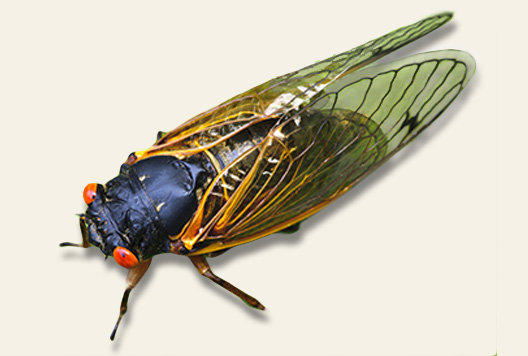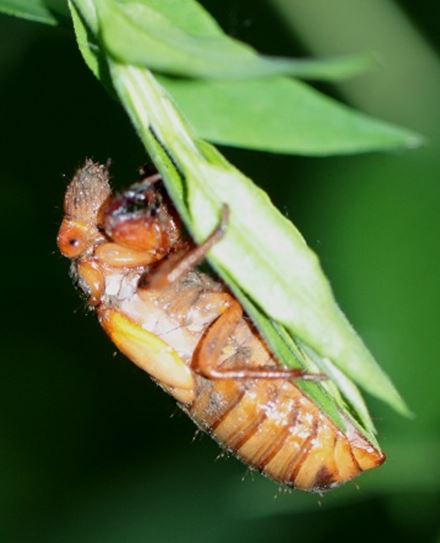- This forum has 0 topics, and was last updated No Topics by .
 In the summer of 2012, the Iowa Brood of seventeen-year cicadas emerged. In the mature-oak lawns of Des Moines, Iowa, in the South-of-Grand area, one could find newly surfaced bugs creeping up stems, splitting their old skins, and struggling out with crumpled, moist wings. Soon, the branches above hummed with their din. In hand, their red eyes contrasted with their black bodies, as did the golden brown veins in their wings.
In the summer of 2012, the Iowa Brood of seventeen-year cicadas emerged. In the mature-oak lawns of Des Moines, Iowa, in the South-of-Grand area, one could find newly surfaced bugs creeping up stems, splitting their old skins, and struggling out with crumpled, moist wings. Soon, the branches above hummed with their din. In hand, their red eyes contrasted with their black bodies, as did the golden brown veins in their wings.
Late in summer, the ends of the oak and other hardwood branches dropped to the ground, weakened by the females’ egg-laying and riddled with the slash marks of each egg deposit. At some point, the eggs hatched, and the very young cicada nymphs began their journey underground, to wait for almost seventeen years before repeating this unusual cycle. I made sure to place a number of these twigs in places where the lawn mowers and foot traffic would not impede the maturing eggs and actions of the hatchlings.

In Greene County to the west, the woodland and shrubs edges of Tipton Prairie, a four-acre remnant, throbbed with the tens of thousands of cicadas. It was easy to photograph them as they whirred their wings. A dozen bugs might line a couple feet of shrubby twig, and sometimes they bumped into each other with mutual annoyance, setting off more wing-whirs.
Southern Iowa experienced an emergence in 1980, part of a different brood. That brood emerged again in 1997 and 2014, although I wasn’t present to witness those events. In 1980, the big trees in Lamoni rang with the incessant shrill sound. The photographer for the Graceland Tower, Dave Gillaspey, shot a number of stills and wrote a feature article on the outbreak.
* * * * *
In the years since 1980 and 2012, I studied the native societies of the Prairie-Plains region, along with the Wisconsin glaciation and Midwestern bedrock. As a result, I’ve become more sensitive to long cycles and time periods that exceed our lifespans, our fascination with quarterly earnings statements, and other limitations on our comprehension of the past – and the future. The periodical cicadas (there are at least three each of thirteen- and seventeen-year species) make up a serious, if also relatively short cycle, one of many for which we humans have little or no regard until the crescendo of buzzing assails our ears.
In choosing an “avatar” for this web site, I settled on the seventeen-year cicada, Magicicada septendecim, as symbol of our inattention to medium and long time pans. I watch suburban sprawl around central Iowa and wonder if any populations of Magicicada (from Latin, meaning “more cicada”) were wiped out by the dozing, excavation of foundations, street paving, and topsoil removal that accompanies our time-deficient land uses. The Magi- part of the name also suggests a “magical” quality to these insects because of their infrequent appearances above ground and their mysterious lives out of sight.
Can we achieve this interdependence for twenty cicada lifetimes? For 500 generations of Prairie Three-Awn? For the span of ten floods with a 0.2% annual risk (the so-called 500-year flood)?

We humans suffer from a fear of time, possibly because we cannot control it, although calendars, clocks, digital devices, medical advances, and schedules offer an illusion of control. Our fear, and also our disregard for other time spans, is driven mostly by our lifespans, which are getting longer in developed nations because of healthier living conditions and medical advances. Our individual lives are certainly longer than the single day of many mayflies or the growing season of the annual Prairie Three-Awn Grass, Aristida oligantha. But our lives also are rather short compared to the Galapagos tortoises, most hardwood trees in any nearby woods, the lichen colonies on those threes, and other, more distant examples: bristlecone pines, desert creosote bushes, underground fungi, and many others.
I think it is crucial to rewild our sense of time. We rely too much on clocks and cell phones and other clever devices, when natural timepieces exist everywhere around us. The dawn chorus of birdsong, the sun’s position in the sky, the flowering and seeding times of plants, the migrations of birds and insects, the movements of fish up and down the rivers. The time differences between Iowa’s different landforms; the ironic preservation of a few hours’ or days’ sand ripples in sandstone that is 100 or 300 million years old; the time required for a stream to move a grain of sand from the stream’s head to its junction with a river, gulf, sea, or ocean; the pulse of a river moving from one side of its valley to the other.
How long after blossoming do blackberries and juneberries ripen? Until hickory nuts and walnuts drop to the ground? How long until walleye fingerlings become mature? What is the timespan for a cicada to begin and end its upward burrowing toward warmer soil and sunlight?

You see, time in all different cycles, processes, and scales is everywhere around us, and we are oblivious to most of it. Partly this is because we focus on the selfish utilitarian needs that are shaped by our economic and social conditions. Yet our ancestors relied on at least some of these natural markers for their own survival. This loss of our own histories is yet another element of our cultural disregard for most other time spans. Their attunement to these natural cycles and occurrences made our existence possible.
In part, this ignorance stems from a kind of arrogance, that our ways are unquestionably best, a mighty improvement over both the ways of our ancestors and the processes of the natural world. We believe that we were destined to separate ourselves from savage and barbaric pasts that relied heavily on nature, by using our wits to shape human conditions that are independent of these dependencies.
This arrogance – this failure to tune in to nature and other kinds of time – this sense that humans are “special” in comparison to wild beasts – is our doom. In the end, we depend utterly on uncontrollable cycles, some of which we have altered for the worse, like the erosional and depositional cycles of farmed and populated land. Others – the sunspot cycle, the spin of our arm of the galaxy – we had best leave alone, if we ever acquire the capacity to change them.
Overall, the lesson is to let all natural processes be as they are and minimize our will to alter them. How do we live in the present to fashion a better future for all living things, humans included, but especially the life forms and their cycles on which we still rely, albeit with arrogant ignorance? Can we achieve this interdependence for twenty cicada lifetimes? For 500 generations of Prairie Three-Awn? For the span of ten floods with a 0.2% annual risk (the so-called 500-year flood)?
These are the wild ideas that spring from my wondering about periodical cicadas, the duration of late prehistoric native societies, and the fine layering in a sandstone bluff. You may find these musings insightful, but I challenge you to enter these wilds of time for your own insights. What will they mean for you, personally? For us as a species and our relationships with all the living and nonliving forms on this earth? For our engagement with other senses of time and the longer cycles that now depend on our decisions?
Leland Searles
Marshalltown, Iowa
January 30 & 31, 2020
